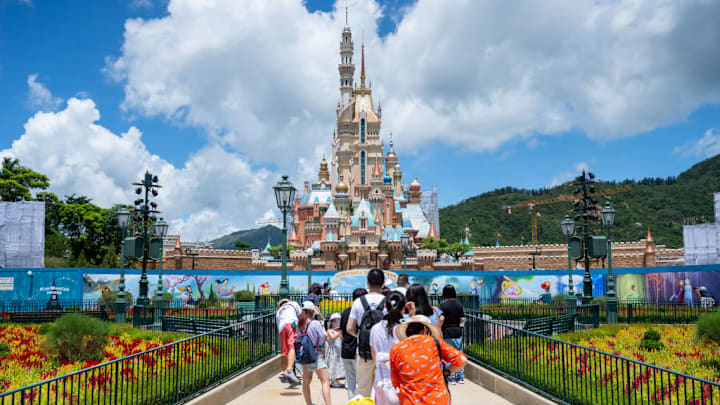Many of the attractions at Hong Kong Disneyland would look familiar to fans of the original theme park. Rides like Dumbo the Flying Elephant, It’s a Small World, and Mad Hatter Tea Cups are faithful recreations of their counterparts operating 12,000 miles away in Anaheim, California.
It’s not as easy to identify the American inspiration behind Mystic Manor. Though the ride lacks skeletons, ghosts, and punny gravestones, it’s a spin on Disney’s beloved Haunted Mansion. In the Hong Kong version, a mischievous monkey unlocks his owner’s magic music box and brings the animatronic artifacts in the labyrinthine house to life.
The story manages to be funny and spooky without an appearance from one Grim Grinning Ghost, and that’s by design. Mystic Manor exemplifies the considerations that need to be made when adapting American entertainment for an international audience, especially when death is a major theme.
A Ride to Die For
The original Haunted Mansion opened in Disneyland in California in 1969. The attraction took the concept of the walk-through haunted house popularized during the Great Depression and reimagined it with Hollywood-level special effects.
After being welcomed by their “Ghost Host” (the disembodied voice of legendary voice actor Paul Frees), guests are ushered into a room where seemingly ordinary paintings stretch and morph into macabre scenes. For the ride portion, a “Doom Buggy” ferries riders past hitchhiking ghosts, a ghoulish bride, and a psychic who resides in her own crystal ball. The characters are brought to life through impressive animatronics and holograms. The tone of the story is equal parts haunting and humorous, which helped the ride become one of the most popular Disneyland attractions of all time. A version of the Haunted Mansion has appeared in almost every location where Disneyland has opened in the decades since.
When Disney debuted its second park in Orlando in 1971, The Haunted Mansion was among the opening-day attractions. Adapting it was simple; the biggest difference was the facade, which was changed from New Orleans Southern Gothic to a more “exotic” (at least from a Floridian perspective) Northeastern architectural style. Bringing the concept to Hong Kong Disneyland over 40 years later would prove to be more complicated.
Lost in Translation
Ghosts are viewed differently in Hong Kong and China than they are in the U.S. Ancestor worship is part of many people’s everyday religious practices, so spirits are usually regarded with reverence rather than levity.
“Scary” ghosts are also part of the culture, but they’re not a laughing matter. While supernatural horror stories can be a form of escapist entertainment in the U.S., people in Hong Kong and China are more likely to view malevolent spirits as a serious threat. Within the culture, anything from health problems to relationship troubles can be traced back to them.
Death is associated with a tangible form of bad luck that sticks to whoever crosses its path (some anthropologists even refer to this as “death pollution”). There are many rituals mourners follow to purify themselves following the death of a loved one. If the deceased passed at home, they may open all the windows or clean the house to rid it of unwanted energy. So while an animatronic ghost holding a head in a hatbox may entertain American audiences, such depictions of death may be confusing at best to native Hong Kongers and disturbing at worst.
“We wanted to be sensitive to any cultural concerns regarding ghosts or the spirit world with our Asian guests,” Mark Schirmer, executive creative director for Walt Disney Imagineering, said in a statement reported by The Escapist. “So just lifting the idea of The Haunted Mansion from our other parks really wasn’t going to work. But the idea of mystery, intrigue, and the supernatural we thought may have a broader appeal.”
A Not-So-Haunted Mansion
For the Hong Kong version of The Haunted Mansion, Disney’s Imagineers thought outside the hatbox. Mystic Manor doesn’t adhere to any of the common tropes associated with haunted houses in the U.S. Instead, it follows the original story of Lord Henry Mystic and his pet monkey, Albert. They live together in an old mansion filled with rare artifacts that Henry has collected through his travels, including an enchanted music box.
Albert the monkey can’t resist unlocking the box, and it releases a cloud of magic dust that makes the objects in the house come alive. As riders progress through the house, they’re treated to dancing instruments and medieval weapons instead of singing ghosts and ghouls. You can watch a ride-through video below.
The attraction captures the mystical spirit of the original while being mindful of local cultural sensitivities. Striking that balance wasn’t simple, which could explain why it took Disney eight years to launch the ride after opening their Hong Kong park in 2005. Those years of planning paid off: In 2013, Mystic Manor opened and was later honored with the Themed Entertainment Association’s award for outstanding achievement in attractions, all thanks to its original storyline and use of special effects and audio-animatronics technology (also, for its trackless vehicles and musical score by Danny Elfman).
Today, Mystic Manor is one of five “Haunted Mansion” rides operating in Disney parks around the world. Others have been tailored to suit their location; Phantom Manor in Disneyland Paris takes a darker, more mature tone, for example. But Hong Kong Disneyland’s take is the most dramatic departure from the Anaheim attraction. Shanghai Disneyland is currently the only Disney park without a Haunted Mansion, which is likely due to the same cultural differences that kept one out of Hong Kong for so long. If Shanghai Disney ever wants to change that, they have a successful blueprint to follow.
